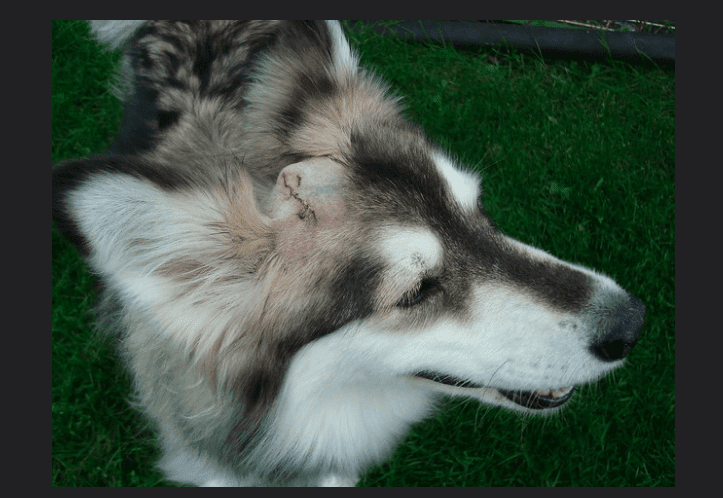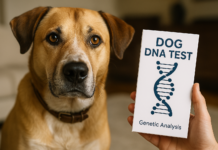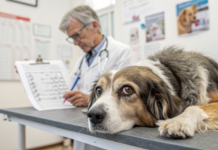Last Updated on July 16, 2021 by Dogs Vets
Sebaceous Cysts in Dogs
What’s is Sebaceous Cyst?
Sebaceous cysts are membranous pockets or sacs that contain fluid, air, or other substances. Cysts can grow almost anywhere in your body or under your skin.
There are many different types of cysts. Most cysts are benign or non-cancerous.
Whether a cyst needs treatment depends on many factors, including
The Type Of Cyst
- The location of the cyst
- If the cyst is causing pain or discomfort
- Whether the cyst is infected
Sebaceous Cysts Overview
- Sebaceous cysts usually appear as small, raised, well-defined, round structures in the skin.
- Pet owners will first notice sebaceous cysts when they notice raised bumps on their dog’s skin.
- Sebaceous cysts can occur anywhere but may be more common on the head, neck, and trunk.
- It is important to discuss any new lumps with your veterinarian so they can be properly diagnosed.
- Cysts are usually benign and slow-growing, so they usually do not require treatment unless they are troublesome.
- In most cases, sebaceous cysts will not go away with medication and they usually need to be surgically removed.
Finding a new lump on your dog can be frightening. Whenever you find a new lump or bump, be sure to meet with your veterinarian to make sure it’s not something serious. But the good news is that not all lumps and bumps are cause for concern.
A common but benign type of skin lump that occurs in dogs is a sebaceous cyst. These lumps grow slowly and may occasionally rupture, but in most cases, they are harmless to your dog.
Knowing how to identify and treat sebaceous cysts in dogs can help you ensure that your dog’s skin is as healthy as possible.
More on sebaceous cysts?
Dogs have many microscopic structures in their skin called sebaceous glands. These glands are responsible for producing sebum, an oily or waxy substance that lubricates the skin and hair shaft.
A sebaceous cyst is a dilatation (opening) of the ducts within the sebaceous glands that causes fluid to accumulate.
True sebaceous cysts are rare in dogs, but the term is often used interchangeably with other types of cysts.
Follicular cysts (sac-like structures usually associated with hair follicles) are more common in dogs but are usually included in this general term.
What do sebaceous cysts look like in dogs?
Sebaceous cysts usually appear as small, raised, well-defined, round structures in the skin. Usually, these cysts are solitary, but some dogs may be prone to having multiple cysts in the same area of the body.

Sebaceous cysts may become hard or feel filled with fluid. If the cysts are infected, they may be red, inflamed, and painful. Sebaceous cysts sometimes rupture and may drain fluid, pus, or blood.
What causes sebaceous cysts in dogs?
In most cases, we do not know what causes sebaceous cysts in dogs. Some dogs may be more susceptible to developing sebaceous cysts due to their genetic predisposition.
Others may develop cysts due to skin infections, scar tissue, trauma, or inflammation. Fortunately, in most cases, we do not need to know what is causing the cyst in order to treat it.
Most pet owners will first notice a sebaceous cyst when they notice a bulge in their dog’s skin. The size of the bump can range from 0.5 cm to 5 cm-about the size of a pea to four quarters of a pound.
Sebaceous cysts are usually slow-growing and may not bother the dog at all.
Other signs of a sebaceous cyst may include:
- Swelling or redness of the area
- Pain
- Hair loss around the alopecia
- Drainage of pus
Common places where sebaceous cysts develop in dogs
Sebaceous cysts can occur anywhere on the body but may be more common on the head, neck, and trunk. Some dogs will develop multiple cysts around the ears or anus.
Sometimes, sebaceous cysts develop on pressure points such as the hips and elbows, especially if the dog is often lying on a hard surface.
How to diagnose sebaceous cysts
It is always important to discuss any new masses with your veterinarian so that they can be properly diagnosed.
Your veterinarian will perform a thorough physical examination of your dog, including an assessment of the location, size, and appearance of the assess bumps.
Your veterinarian may also recommend the following tests.
Fine needle aspiration and cytology
Your veterinarian may recommend that you use a needle and syringe to take a sample from the bump. This sample can then be examined under a microscope. Often, your veterinarian can determine whether the mass is a cyst or a tumor based on this sample.
Biopsy: In some cases, a proper sample cannot be obtained using only a needle. When this occurs, your veterinarian recommends that you surgically remove all or part of the mass and submit it to a diagnostic laboratory for evaluation. Usually, this is the best way to obtain a definitive diagnosis.
What causes sebaceous cysts in dogs
Now that you know what a sebaceous cyst on your dog’s skin is, you may be wondering what causes it and how to get rid of it. Well, each skin pore contains a hair follicle that is surrounded by tiny oil glands called sebaceous glands.
These glands produce an oily substance called sebum, which keeps your dog’s skin and coat lubricated and shiny. The sebaceous gland ducts drain into the hair follicle causing a cyst to form.
It is believed that dog sebaceous cysts (or dog sebaceous cysts, if you prefer) form when hair follicles (and therefore skin pores) become blocked by scar tissue, debris, dirt, or due to infection, resulting in an abnormal buildup.
Sebum: When sebum is too thick in texture, it can also clog hair follicles and skin pores, causing sebaceous cysts to form on the dog’s skin.
Canine sebaceous cysts may or may not have visible hair in the center and are usually slow-growing. Your furry friend can get one or more cysts at a time. Others get these cysts on a regular basis.
Removal and treatment options for dogs with sebaceous cysts
I’ve seen people on forums asking how to remove sebaceous cysts in dogs.
Cysts usually start small and slow-growing, so they usually do not require treatment. Your veterinarian may recommend that you only monitor the area.
If the cysts are growing or bothering your dog, your veterinarian may recommend surgical removal. It is best not to pop these cysts at home. Doing so may cause inflammation and infection, and maybe pain for your dog.
As mentioned earlier, canine sebaceous cysts are painless and resolve themselves without treatment. As long as the cyst is small, intact (i.e., not ruptured), and not inflamed (hence the change in color from white to red), it can be set aside. Another cause for concern is that sebaceous cysts grow too quickly.
There is always the temptation to squeeze the cyst forward, but as Dr. Becker says, you should not do this because it can trigger a bacterial skin infection (cellulitis), in which you will be prescribed to take some antibiotics for the treatment.
As for dog sebaceous cysts that can rupture (burst) themselves, they simply need to be disinfected and kept clean, but if they become infected, your veterinarian will prescribe antibiotics and anti-inflammatory medication.
Your veterinarian may also deem it necessary to surgically remove canine sebaceous cysts.
This is often necessary for certain cases of infection (especially those associated with purulent discharge) and inflammation, as well as for ruptured sebaceous pouches that cause a lot of bleeding.
Dog cysts that have a significant impact on your furry friend’s quality of life may also need to be surgically removed.
Medications to treat sebaceous cysts in dogs
In most cases, sebaceous cysts will not go away with medication alone. The only way to eventually cure a sebaceous cyst is to surgically remove the cyst.
However, if the cyst is infected, your veterinarian may prescribe medications to help resolve the problem. These medications may include
Antibiotics: If your dog’s cyst is infected, your veterinarian may prescribe antibiotics to treat the infection.
Cost of Cyst Removal in Dogs
As part of this study, I worked to try to determine the cost of removing sebaceous cysts from the skin of dogs. I found that the cost varied greatly from one location to another and from facility to facility.
It seemed to vary between $200 and $1500. This can include sedation fees, facility fees, and medications. The need for a biopsy can also have an impact on the cost. The number of cysts to be removed will also have an impact on the cost.
It can be difficult for a veterinarian to give you an accurate price without considering the cysts.
Most facilities have payment plans, so don’t be afraid to ask.
Preventing sebaceous cysts in dogs
There is little you can do to prevent sebaceous cysts in dogs, but there is always something you can do to reduce the chances of them forming by taking proper care of your dog’s skin and coat.
Here are some tips.
Brush and groom your dog frequently. Not only does this help remove dander and allow sebum to flow smoothly out of the skin pores, but it also helps to enhance bonding with your furry pet.
Increase your dog’s intake of dietary fatty acids. These help to keep sebum production at optimal levels. Adding a source of omega 3 fatty acids (such as krill oil) is a good way to achieve this, as is coconut oil.
Avoid over-bathing as well as not bathing your dog. Different breeds require different agitation frequencies depending on the nature of their coat.
A grooming specialist can help you determine the best frequency for a particular breed.
Frequently Asked Questions
Can I pop sebaceous cysts on my dog?
If they get large, then the tremendous pressure may cause them to rupture, which may or may not lead to infection. I would never recommend that you squeeze them out yourself, as this in itself may lead to infection.
What do sebaceous cysts look like in dogs?
All dogs and cats, purebred or not, can have sebaceous cysts. Cysts look like small closed lumps that remain white in color and grow out of the skin.
When touched, they feel like small, round, or oval lumps under the skin. If your pet has a sebaceous cyst, you will notice raised bumps.
Can I put a needle in a sebaceous cyst?
Small, uninfected sebaceous cysts are simple to treat if they are completely necessary. The top of the cyst is cut open with a needle prick or with a scalpel and the contents are squeezed out.
Can I expel a sebaceous cyst on my own?
Although you may want to pop the cyst out, never squeeze or pick up the cyst. Most cysts are almost impossible to squeeze out with just your fingers. Alternatively, you can spread bacteria and sebum beneath the follicle, causing these to spread and form more cysts.
What happens if a cyst is not treated?
If left untreated, benign cysts can cause serious complications, including Infection – The cyst is always filled with bacteria and pus and becomes an abscess. If the abscess ruptures inside the body, there is a risk of blood poisoning (septicemia).
How long do sebaceous cysts last?
Sebaceous cysts form when the opening to the sebaceous glands is blocked. The oily substance called sebum continues to be produced, but cannot escape to the outer surface of the skin. Cysts may remain small for a few years or may continue to get larger
Read also: Top 10 best dog breeds for seniors in 2021
Fact Check
We strive to provide the latest valuable information for pet lovers with accuracy and fairness. If you would like to add to this post or advertise with us, don’t hesitate to reach us. If you see something that doesn’t look right, contact us!
Reference: greatpetcare.com


















